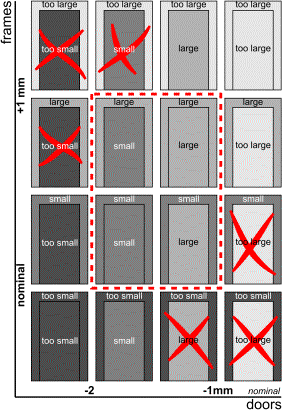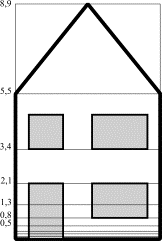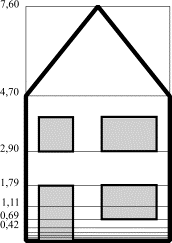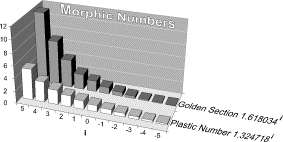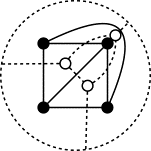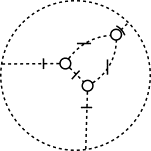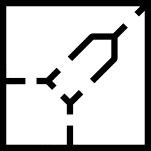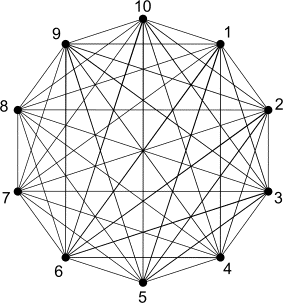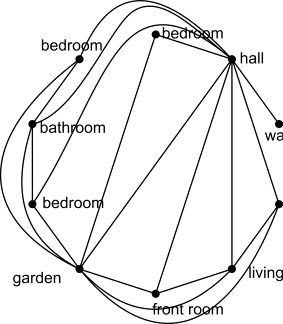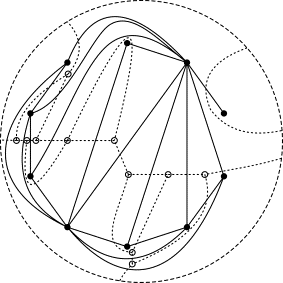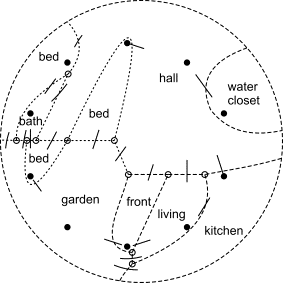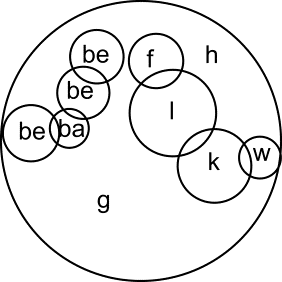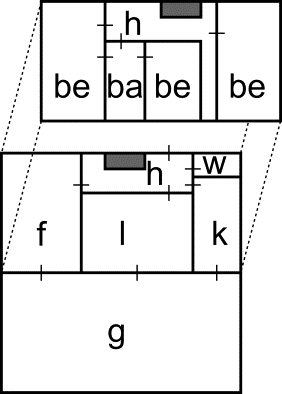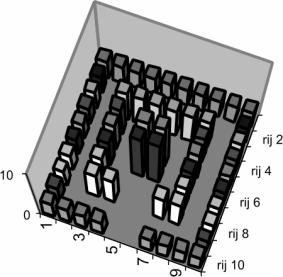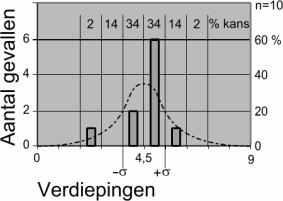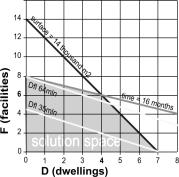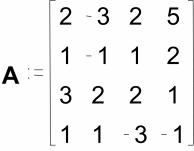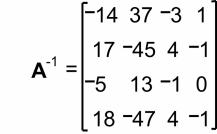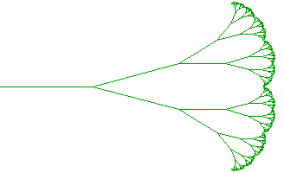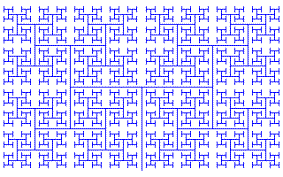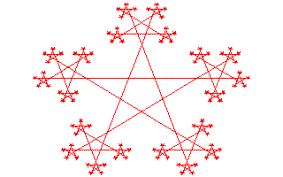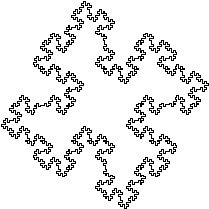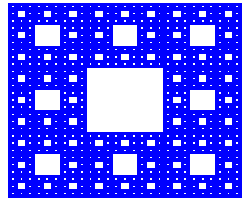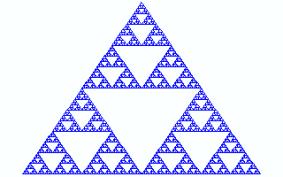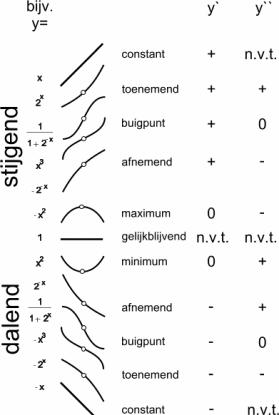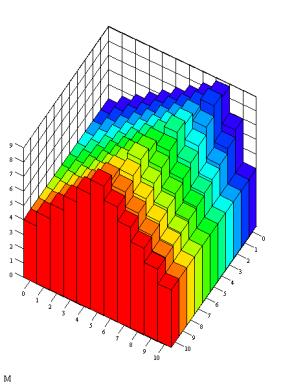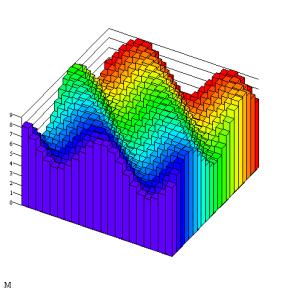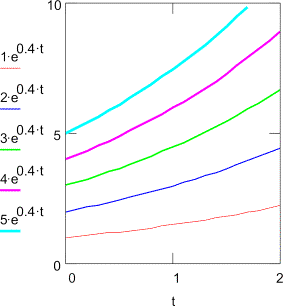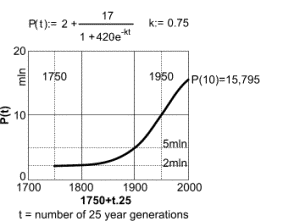24
Mathematical Models
Taeke
de Jong, R.P. de Graaf
24.1 Origins.................................................................... 2
24.2 The mathematical model is no
reality...................... 2
24.3 Mathematics is the language of
repetition.............. 3
24.4 Numbering(serial, sequence)................................. 3
24.5 Counting................................................................. 3
24.6 Values and variables............................................. 4
24.7 Combinatorics........................................................ 5
24.8 Taming combinatorial explosions........................... 7
24.9 The programme of a site........................................ 8
24.10 The resolution of a medium.................................... 9
24.11 The tolerance of production................................. 11
24.12 Nominal size systems.......................................... 12
24.13 Geometry............................................................. 18
24.14 Graphs................................................................. 20
24.15 Probability............................................................. 25
24.16 Linear Programming (LP)...................................... 27
24.17 Matrix calculation................................................. 29
24.18 The Simplex Method............................................. 30
24.19 Functions............................................................. 32
24.20 Fractals................................................................ 32
24.21 Differentiation....................................................... 33
24.22 Integration............................................................ 34
24.23 Differential equations........................................... 37
24.24 Systems modelling............................................... 38
A curriculum in mathematics for the Architecture Faculty at Delft University, taught for a few
years during the nineties by the Mathematics Faculty, was ill-suited to the
architecture staff, including its examples and references. So, the students who
could not understand what use it was, experienced more nuisance than stimuli
while designing, and were avoiding mathematics in the curriculum as a whole,
where other disciplines could compensate for low grades in mathematics. The
practice of design was doing well with high-school maths with some extensions,
so why bother?
The realistic production of form is,
as always, superior to the abstract mathematical detour via form description by
Cartesian co-ordinates, even if fractal forms are generated. The mathematician and designer Alexander has been more successful with his ‘Pattern Language’ [1] than with his ‘Notes on the Synthesis of Form’.[2] The remainder of mechanics and construction physics is being taken care
of by specialised consultant agencies and computers following delivery of a
sketched design. No senior designer has any recollection of the content of
mathematical education (s)he was exposed to during the sixties and seventies,
when it was compulsory, while the practice featured nothing that might benefit
from remembrance.
Of the lecture notes on
architecture, ‘geometry’, ‘graph theory’, ‘transformations and symmetries’,
‘matrix calculation’ and ‘linear optimising’, ‘statistics’, ‘differential and
integral calculation’ composed and, in the nineties, introduced in a simple
form with the problem-orientated education only the latter may be found in the
Faculty’s bookshop anno 2002. This last relict is due to the tenacity of the
sector Physics of Construction. During the more mature years of building
management matrix calculation for optimising exercises is being brushed-up from
high-school maths. Then one is lacking the lost foundation in the first year.
With the slow filtering-through of end-user friendly computer applications, as
there are spreadsheets and CAD (pixel and vector presentations of form) during
designing a new interest is dawning. Computer programs like Excel, MathCad,
Maple or MatLab do ease experimenting with mathematical formulae as never
before.
From these mathematical ingredients,
also adopted by Broadbent[3] as relevant to architectural design, Maybe a new mathematics for
architecture might be composed. Architecture itself and civil engineering, it
should be remembered, were standing at the cradle of mathematics. This Chapter
does not pretend to stand at the birth of a new building mathesis. As urban
architects, its authors fall short of the proper attainments. However, it gives
a global survey of mathematical forms that may be employed in architectural
design – with a reading list – providing linkage with a new element as a point
of departure: combinatorics. Whoever wants to brush up on
high-school maths[4] or to get a bird’s eye view of mathematics as a whole[5] is referred to publications pertaining thereto. Experimenting with the Excel computer programme is especially recommended. In spite of that, Euclid’s answer to the question whether
there would not be a simpler way to study geometry than his ‘Elements’[6] is still applicable: “There is no regal road to geometry’.
24.1 Origins
Mathematics is a language developed
in order to describe locations, sizes (geometry), numbers (arithmetic)[7] and developments from observations (measurements and counts), to
process these descriptions and to predict new observations on that basis. In
this vein, until 500 BC, for the founding of cities in Greek colonies a square of 50 x 50 plethra (a ‘plethron’ is some 30 metres) was paced off thanks to a
diagonal of 70 plethra, in order to realise straight
corners.
|
|
|
Figure 1 Pythagoras |
Pythagoras (580 – 500 BC) – or one of his pupils – next provided the
well-known proof that the ratio should be slightly larger than 7 to 5; while
the square of 7 is just one unit less than 25 + 25. From the womb of geometry,
thus, the arithmetical insight was born that real
numbers RR exist – such as the square root of 2,
or the real length, derived therefrom, of the diagonal – not to be attained by
simple partitioning (rational, QQ) of natural
numbers (NN = 1, 2, 3 …). Geometry – literally:
‘measuring of the land’ – owns its first described development to the annual
flooding of the river Nile. In ancient Egypt, floods wiped out the borders
between estates and property, so that each year it had to be determined
geometrically who owns what; as seen from standpoints which were not flooded. Arithmetic has roots in Phoenician trade. The Greek Euclid (around 300 BC) collected knowledge in both senses of his day and
age in his book ‘Elements’, (via the Arab world) the cornerstone of all education in geometry well
into the twentieth century. Euclid used earlier texts, but derived as the first
the propositions of geometry by logical reasoning from 5 axioms.[8] With this, a process was completed emancipating mathematics from
empirical practice of measuring and counting examples.
24.2 The mathematical model is no reality
Since then, mathematics can, like
logic, without observing the sizes of input (non-empirically, a priori) come to
new forms of insight (synthetic judgements). Logical proof dominating, they
are accepted as new insight also without observing sizes of output. The
philosopher Kant (1724 – 1804) struggled with the question how that is possible at
all: synthetic judgement a priori.[9] For an empirical-scholarly theory always states that in the case of an
independent observation from a set X, a corresponding independent observation from a set Y follows.
If the elements of X and Y may be put in a corresponding, following, order so
that they form the variable x and y, one may interpolate observations that have not been
performed, while at constant conditions (ceteris
paribus) – not included in the model – extrapolating to the future. A regularity of their correspondence is regarded as
a working between them: y(x). Probable (causal) as well as possible (conditional) workings exist. If, for instance,
the size of the population (x) is increasing, the number of buildings (y) is
increasing as well following a hypothetical working y(x).
The larger the number of
observations (n), the more convincing the theory. If one can demonstrate, by
way of one hundred time sequences[10] (n = 100) that between the two of them a working (function) may be defined that convinces more
than one single correspondence in the past year (n = 1). At larger numbers of
independent input observations, the scholar can look for a mathematical working
y = f(x) (e.g. y = ½ x) producing the same results as dependent observing
(modelling). A just input and output must show a perceptible relation to
reality, not the mathematical operations employed by way of a model. Different
(mathematical or real) workings (functions) may yield the same result. As soon
as other facts are observed than those predicted, the empirical theory is rejected; not necessarily the mathematical discourse playing a
rôle therein; although the two occasionally get confused. If the predictions
are confirmed, in its turn, the mathematical working model is often regarded as
‘discovered’ reality (‘God always calculates’)[11]. However, this is not necessary in order to accept a theory (until the
opposite has been proven).
24.3 Mathematics is the language of repetition
Just as in daily parlance, in logic
and mathematics as well, concepts (statements, expressions)
are used and composed into a model (declarations, sentences,
full-sentence functions[12], workings, functions) with operators
like verbs and conjunctions. Logic is using these operators
particularly in the case of conjunctions (for instance: if P, then Q) mathematics the verbs (functions
such as adding and summing). Logical deductions in mathematics usually have the
logical linguistic form: ‘if working P, then working Q’. However daily parlance
has the capacity to name unique performances. This primal declarative function of everyday language has the character of a contract. Only when
the performance has been witnessed anew is there a rational ground to start
counting. What is repetitive is food for mathematics. For all
mathematical operating, name-giving, as in everyday language, is – usually
implicitly – pre-supposed. However, mathematics is of no use in unique
performances. If one stone weighs one kilogram, then two stones weigh only two
kilograms if they are ‘equal’. This equality (here in terms of size and material) can only be agreed on by normal
words. Sub-dividing dissimilar stones in equal fragments (transforming sizes in
numbers, analysis) can make unique specimens elective for counting, and then for mathematical operations based on that counting. The question whether that can be done will
always remain; as in Solomon’s judgement: two times half a child means no
child anymore. In analysis a connectivity, incorporating the essence of the
architectural object, may get lost and will remain lost during synthesis to a
different magnitude (counting). The scale paradox may be a nuisance while sub-dividing an object again and again in
increasingly smaller parts, in order to compose next from this a different
order of magnitude or to predict it (infinitesimal
calculation, differential
and integral calculation). The other, lost properties – in a
specific context – may be taken into account next in the formulae (increasing validation, see page ), but this is just shifting the
problem.
24.4 Numbering(serial, sequence)
Numbering(serial)
just pre-supposes difference in place, not similarity
in nature. I can enumerate the total of
different objects in my room (or letter them) in order to be able to see later
whether I am missing something, but this numbering(serial) does not allow
mathematical operations. In spite of the fact that they are mathematically
greatly important, since ordered difference of place (sequencing) is crucial in number theory.[13] The number(serial) serves as a label, name, identification (identification number, ID
number, or index, in the case of variables) that may
prevent exchanging, missing and double counting. By the same token, it is
impossible to calculate with these numbers, although ‘numbering(serial)’ is
pre-supposed silently in the case of ‘counting’. Sequencing of numbers has in
principle no other purpose than that it is staying the same, even if the
numbered objects are changing later in place. The number stabilises differences
in place ever witnessed as if on a photograph.
Nevertheless, the sequence, in which
one is numbering(serial), often gets, in practice, a meaning (for instance: in
the order of arrival), allowing conclusions. Although one is inclined to
introduce with an eye on that some logic in a numbering (categorising), it is halted sooner or later,
while numbering is incurring lapses or lack of space. At current capabilities
of information processing, this is why it is advisable, for instance, to open
in a spreadsheet a database next to the column with sequential
identification numbers (always to be produced independent of the shifting row and column
numbers!) new columns in order to distinguish categories on which one wants to
sort. For the mathematics it is important that it is possible to number(serial)
input and output numbers, to index, identify and retrieve from a database in a
fixed sequence and combination. The number(serial) is the carrier of the
difference of place in a database. A reliable database is carrier of
differences in nature and place in the reality (not that nature and place
itself). To ensure that an identification code will always be pointing at the same object it should be invariant
during the existence of that object. Additionally it is not allowed to have
meaning in terms of content, such as a postal code and house number combination, for this changes in the case of home-moving the
corresponding ‘object’.
24.5 Counting
Observations can only be expressed
mathematically if they are occurring more than once (in a comparable context)
and may be harboured as ‘equal’ in any sense in a set. Only then can one count them. The equality pre-supposition of set theory and mathematics is sometimes forgotten, or all too
readily dissolved, by analysis (changing scale by concerning smaller parts). In
this way an area of 1000 m2 can be measured by counting, but each
square metre has in many respects a different value that makes the area found
in itself (without weighing) meaningless. The equality pre-supposition can lead
to mathematical applications without sense, when the set described is too
heterogeneous qua context or object for weighing. In this vein I can count the
number of objects in my room, but each and every mathematical operation on this
number alone does not lead to useable conclusions. Some objects are large,
others small, some valuable, others not; or not elsewhere. From the number I
might perhaps derive the number of operations in case of moving home, but these
actions will be differing in their turn with the nature of the objects. Still I
can say: “If I throw away something, I have less to move.” If I throw away a
moving box with that argument, I have less to move, but this has no relation
anymore with the effort (larger without the box) of moving that may have
fostered the argument. Mathematical modelling would be misleading here and
requires a comparable context.
So: some equality in nature is already pre-supposed when it comes to counting. Curiously
enough, a difference is also pre-supposed: when counting, I am not allowed to
point at the ‘same’ object twice (double counting). The objects pointed at should
differ! What this difference in identity exactly is, is left here undecided;[14] for reasons of convenience we call it ‘difference
of place’, although this does not cover, for
instance, the problems involved in counting moveable objects like butterflies
on a shrub, mutually exchanging places. A number, or variable, therefore
pre-supposes equality of nature and difference of place, even if that place is
not always the same.
The equality in nature
pre-supposed when it comes to counting does require the definition of a set (determining which objects we count or not). This definition is
pre-supposing within the set defined equality, but at the same time to the
outside difference with other sets. This paradox is explained elsewhere in the
book as a ‘paradox of scale’ or ‘change in abstraction, see page . In addition the ‘nature’ is not
possible to change during counting. It is not allowed to use one century for
counting one basket of apples, since it is likely that after an age like that
the apples will not exist anymore.
The difference of place pre-supposed
at the moment of counting does require a unique indication of place (which objects were already dealt with or not yet). By the same
token such an indication of place is pre-supposing distances between the places (intervals) or between their centres (core to
core distance); if that would not apply they
would not differ and be unique. The size of the places indicated (scale) should be equal to the one
of the objects placed (extension); if that would not apply one place
could contain several similar objects, pre-empting identification of the
objects themselves. Rather paradoxically, difference of place (uniqueness) is also pre-supposing an equality
of scale (unit or order of magnitude) in order to guarantee that
uniqueness. An object without scale (a point) may still be identified by mutual
intervals. If these are small enough, points may produce a line, a surface or a volume.
24.6 Values and variables
Therefore, we are counting by
pointing at similar objects differing in their various places (in order to
avoid double counting). Since that place may change, we make a snapshot,
stating for the differences of place a randomly chosen, but fixed sequence,
numbering(serial). To each indication a different
name is given, number(serial). The final number is the
number(quantity) or figure. Sometimes the sequence is of no
importance, so that it is possible to restrict oneself to a uniquely
identifying naming (nominal values). When the sequence imports, the
values are termed ‘ordinal’. Next, when the intervals between
the objects numbered are equal, we call the number an ‘integer’. This enables operations with
interval-valuessuch as adding, subtracting, multiplicating and dividing, without the need to indicate,
count or re-count the objects and their places. With this different counts may be predicted from certain counts, but the result may also be a
‘non-object’. By naming this outcome ‘zero’ according to a price-less
discovery of the world of Islam, and even by extending it after boundless
subtracting with ‘negative numbers’ calculating is not restricted to
objects accidentally present.
This is opening the road to
calculation without reference to existing objects. By taking zero for a point
of departure with at both sides the same interval as between the other numbers,
the distance of this zero point to two numbers can provide a relational number
(rational value). This is the foundation for measuring. Sometimes this results in fractions, that may be expressed in ‘rational numbers’. If they are represented as points
on a line of numbers, it becomes apparent that in between the numbers resulting
from division of integral numbers still other values exist (real numbers). Ratios can also yield a relation
between numbers of different kinds of objects (for instance inhabitants per
residence: residential occupation). The set of values of one kind is called ‘variable’. Function
theory tries to work out arithmic rules for predicting, from the development of one variable x, another
variable y. It is often difficult to determine, whether x and y entertain also
a causal relationship, or are just demonstrating some
connection (correlation); for instance on the ground of a
common cause, a third variable, or if a great many causes and conditions are at
work.
Particularly in probability calculus chances and probability distinguishing between these various kinds
of values is important.[15] Then large numbers of results of a process are taken into consideration
and the chance of a few of them is calculated (event). Extreme
values are occurring less often as an outcome of many natural processes
than values in-between. As a measure for the distribution between the extreme outcomes the average and its mean, the median and the modus are used. The average of a large number of values can only relate
to interval values or rational values. In the case of ordinal values, no
average exists, but a median (as many outcomes with a higher as with a lower
value). In the case of nominal values it is also impossible to calculate a
median; then a modus can be used (the number of values occurring most
frequently).
When a set of values X is now
compared to a different set Y in order to find between both a correlation,
various statistical arithmetic methods (tests) exist, depending on the kind of
values representing X and Y:
|
|
Y |
||
|
X |
Nominaal |
Ordinaal |
Interval & rationaal |
|
Nominaal (dichotoom) |
Kruistabel |
Mann-Whitney |
·
Grote steekproef: t-toets/ANOVA ·
Kleine steekproef, Y normaal verdeeld:
t-toets/ANOVA ·
Kleine steekproef, Y niet normaal
verdeeld: Mann-Whitney |
|
Nominaal (niet di-chotoom) |
Kruistabel |
Kruskal-Wallis |
·
Grote steekproef: ANOVA ·
Kleine steekproef, Y normaal
verdeeld: ANOVA ·
Kleine steekproef, Y niet normaal
verdeeld: Kruskal-Wallis |
|
Ordinaal |
n.v.t. |
Rang-correlatie |
·
Rangcorrelatie |
|
Interval & rationaal |
n.v.t. |
n.v.t. |
·
Grote steekproef: Pearson-correlatie ·
Kleine steekproef, X en Y normaal
verdeeld: Pearson correlatie ·
Kleine steekproef, X en Y niet
normaal verdeeld: rangcorrelatie |
|
Table 1 Overzicht toetsen op paarsgewijze
samenhangen tussen twee kansvariabelen X en Y[16] |
|||
In this the nominal values have been
distinguished in dichotomous (yes – no) or non-dichotomous (multi-valueous).
24.7 Combinatorics
As soon as counting has been
mastered, one may name on a higher level of abstraction the internal categories (k), pre-supposed to be homogeneous, and unique places (n) themselves; number and count them. Allocating over the
available places the kinds and within it the number of kindred cases (p) is the
subject of combinatorics. It is pre-supposed in numerical systems and, therefore, a fundamental root of mathematics. This way the
number of possible arrangements of 10 names over 2 places equals 100, over 3 it
is 1000. Due to the Islamic discovery the notation of large numbers by
combination of cipher names has become simple and more accessible to
calculations.
Combinatorics may also be regarded
as a basic science for architectural designing. More generally, one may
calculate the number of possible arrangements, without any restriction, of k
categories over n niches as kn. When it is supposed that 100 different kinds of
building materials (among them air, space) may be used on a site of 100m2,
with 1 mln inter,connecting allocation possibilities of 10 x 10 cm, this is
yielding already in a flat surface many more design
possibilities (1001000000) than there are atoms in the universe (10110). The designer is travelling, so to speak, in a
multiple universe of possibilities, where
the chance of meeting a known design is practically nil. With this, to all
practical purposes, infinite number of possibilities no rational choice is possible by taking them all into account. Also, when restricted
by a programme of requirements, in which the units ‘space’ must be
positioned in certain amounts in inter-connection, the number of possibilities
is still practically infinite. The various mathematical disciplines passing
muster in the following paragraphs as possibly relevant for architecture, are
described there as rational restrictions of this number of possibilities.
The designer, faced by a white sheet
of paper or a blank screen, is asked to indicate on it difference in place (state of dispersion; form) and in kind (colour). The differences in nature are
contained in a range to be generated (the 'legend', in its original connotation)
spread in k units of colour (e.g. the programme) over n niches (appropriate fields,
for instance on the grounds of the site); the differences in place.
|
|
|
n = 9 k=3, scheme |
|
|
|
n = 100 k=32, rough draft |
|
|
|
n = 256 k=78, Windows-icon |
|
Figure 2 A programme, approx. 1/3 of the site, spread over the ground in 3 resolutions. |
How many different states of
dispersion can be generated in total? In mathematics the branch of combinatorics deals with that kind of 'arrangements' in
finite sets and with counting the possibilities of arrangement under suitable conditions[17].
If a range
of k = 3 colours is available for colouring n = 3 fields, 33 = 27 variations apply. In this way the colours red, white and
blue combined with three fields yield 27 distinct flags.
More
generally: V(n,k) = kn (variations with repetition). With as many colours as niches the expression reads nn.
|
|
|
||||||||
|
aaa |
aba |
aca |
baa |
bba |
bca |
caa |
cba |
cca |
|
|
aab |
abb |
acb |
bab |
bbb |
bcb |
cab |
cbb |
ccb |
|
|
aac |
abc |
acc |
bac |
bbc |
bcc |
cac |
cbc |
ccc |
|
|
Figure 3 V(3,3) = 33 = 27 variations |
|||||||||
Among them, however, there are many
cases in which colours have been repeated or omitted. True 'tricolores' are but
few. The first condition to be added amounts to the presence of all three
colours. Colour one has 3 positions available; for the second 2 remain; and for
the third 1. This limits the number of cases to 3 x 2 x 1 = 6, abbreviated to
3!, so-called permutations. More generally, one may write:
P(n) = n! (permutations without repetition).
|
niches n |
just as much different colours as
niches |
|||||
|
1 |
a |
|
|
|
|
|
|
2 |
ab |
|
ba |
|
|
|
|
3 |
abc |
acb |
bac |
bca |
cab |
cba |
|
|
||||||
|
Figure 4 P(n) = n! : 1, 2 en 6 permutations |
||||||
|
4 |
abcd abdc adbc dabc |
acbd acdb adcb dacb |
bacd badc bdac dbac |
bcad bcda bdca dbca |
cabd cadb cdab dcab |
cbad cbda cdba dcba |
|
Figure 5 P(4) = 4! = 24 permutations |
||||||
24.8 Taming combinatorial explosions
Permutations restrict the ultimate
number of variations: 3!, is less than 33; n! rises less fast than nn,
but faster than, for instance nn/2, when only half the amount of
niches is used for the number of colours ‘Factorials limit the largest powers’.
Yet, permutations do increase fast enough to lead to a 'combinatorial explosion' on higher values for n:
|
|
|
Figure 6 Combinatorial explosions |
How to select from all these
possibilities? To many people this is a crucial question in personal life and
in designing. With so many possibilities a conscious choice does not apply
actually, so that during the reduction of the remaining possibilities, still
not yet imaginable, one is guided by contingency,
emotion of the moment, sensitivity for fashion, or routine. Deelder says: ‘Within
the patches the number of possibilities equals those outside them.”; as
long as the resolution is lowered.[18]
Although mathematics is used
generally in order to arrive at singular
solutions, where different possibilities are
not taken into account to the dismay of the designer, this discipline may also
be used to reduce the remaining possibilities within exactly formulated,
but in other respects freely varying conditions (for instance a scale system of 30 x 30 x 30 cm)[19] and to survey them.
The branches of mathematics relevant
to architecture are therefore seen here as the formulating of these restrictions
on the total amount of possible combinations.
Systems
of measure are mathematical sequences reducing the sizes of components to
convenient sizes.
Geometry restricts itself to connected (contiguous) states of dispersion (shapes) such as lines, planes, contents, which can be described with a few
points and with a minimum of information as to their edges.
Graph
theory restricts itself to the connections between these points (lines with or
without a direction) regardless of their real position.
Topology formulates transformations of forms and surfaces, so that one form can be translated in
another one by a formula. This involves the direct vicinity of each point in
the set of points determining this surface. For minimising the curved surfaces
between the closed curves (soap skins) the forgotten mathematical discipline of
the calculation of variances is necessary.[20] This mathematics is also applied to the tent roof constructions of Frei
Otto. However, this discipline is too
complicated to be introduced in this context.
Probability
theory and its application in statistics restricts itself to the occurrence of well-defined events, for instance the happening of one
or more cases among the possible cases in a given space or time.
Optimising by linear programming aided by matrix calculations formulates the remaining exactly restricted possibilities as the
'solution space’.
Next to these mathematical
restrictions there are any number of intuitive restrictions causing the
disregard of possibilities. If one recognises, for instance, in the
illustrations on page 6 and following the image type of a
door in a wall, the basis of the door (programme k) should lie in the lower
part of the wall (the space present n), unless a staircase is drawn as well.
24.9 The programme of a site
With variations (kn) and factorials or permutations (n!) alone it is impossible to determine the number of cases when
a particular colour has to be present in a predictable amount (a quantitative 'programme' per colour). With a programme for
an available space n, where one colour (for instance black) has always to be
present at least p times P(p,k) = n!/p! possibilities exist (permutations with repetition). The p! in the denominator of the
ratio restricts the explosive effect of n! in the numerator at higher values of
n, except of course, if it equals 1. That applies in the first column of the
figure below; if p = 1 (so p! = 1) it has no effect on the ratio; the number of
permutations P remains, as in the previous example with letters, 4! = 24. At p
= 2 (p! = 2) and p = 3 (p! = 6) the number is restricted.
|
P(4,1) = 4!/1! = 24 |
P(4,2) = 4!/2! = 12 |
P(4,3) = 4!/3! = 4 |
|
|
|
|
|
Figure 7 Permutations in 4 niches, with at least k = {1,2,3} black elements combined with other hues. |
||
The larger the programme p of one
colour (in this case black) with regard to the total space available, the less
possibilities remain for other colours to generate cases. Evidently, p, the
number of colours surfaces to be distributed may not exceed the space n
available.
The formula pre-supposes that the
niches remaining will be filled with as many different colours. They generate
the additional cases, not requiring attention from a programmatic point of
view.
If not only the programme p, but
also the complementary remainder n - p is combined into one colour, no other
colours remain to generate additional cases. A permutation with two colours, p1
and p2 equals the formula n! / p1!p2! The
possible arrangements of programme p1 and the remainder p2 develops into n! /
p!(n-p)! (Newtons binomium)[21].
Within both surfaces, the sequence in which the niches are filled in
with one colour is now irrelevant. The only consideration of importance left is
the number of different instances in which one quantity p is allotted to n
possibilities without a rôle for its own sequencing. This entity plays a
leading part in statistics. Factor p then is the number of
possibilities of an event, n – p is its complement of
possibly not happening that event. So, not only possibilities in space apply: n
may also reflect time. A little counter-intuitively the common expression is 'combinations'; and one simplifies the formula P
(n, p1, p2 ) = n! / p1! p2! to C
(n,p) = n! / p! (n - p)! ; or shorter still:
![]() , 'n over p'.
, 'n over p'.
(combinations without repetition).
|
C(4,1) |
C(4,2) |
C(4,3) |
|
1x2x3x4/ ((1x)(1x2x3)) = 4 |
1x2x3x4/ ((1x2)(1x2)) = 6 |
1x2x3x4/ ((1x2x3)(1)) = 4 |
|
abbb,babb, bbab,bbba |
aabb,abab,abba, baab,baba,bbaa |
aaab, aaba, abaa, baaa |
|
|
|
|
|
Figure 8 Combinations in 4 niches of 2 colours |
||
Without fail, one will experience
the highest level of freedom of design if a one-colour programme occupies half the site available (p1 =
p2); a sound reason to plead with the principal for as much open space as space
built.
At higher resolutions as shown in
the diagrams on page 6 even the number of black-white
combinations rises again explosively C(9,3) = 84, C(100,32) = 140
000 000 000 000 000 000 000 000 (1,4E+26 for short in Excel), the Windows-icon shown (16pixels x 16pixels
= 256pixels), amounts at 78 black pixels C(256,78) already to 1,2149E+67 images. Excel calculates this with the
command = COMBIN(256,78).
Again, the greatest freedom to
design is found in an equal distribution between black and white pixels:
C(256,128) = 3,50456E+75. If 256 colours can be used the variance formula is
256256 (10616 or 22048). This exceeds the
number of atoms in the universe by far (10110 or 2365).
If one studies, for instance, 5625
locations of 1 km2 in the colours 'built' (815) and 'open' (4818),
approximately 101008 or 23349 alternatives exist for the
present 'Randstad' area in the Netherlands. The
average PC cannot deal with this. Excel digests in this case at great pains
p=156.
In this sense the designer is
travelling in a multiple universe of possible forms (states of dispersion). The
chance one runs into a known form is, in this combinatorical explosion,
negligible
The number of elements of the programme (legends units, colours, letters) may be raised above 2; within the
total sum of n, of course.
This enables the calculation of the
numbers of cases belonging to a specified programme on a location. If one wants
to allocate for instance 4 programmatic elements to n fields, there are
P(n,p1,p2,p3,p4)
= n!/p1!p2!p3!p4! design
possibilities. The total of the colour surfaces p1+p2+ …
desired is again not allowed to exceed, of course, the surface available in total n. With a computer programme such as Excel one can
calculate, for instance, that the possibilities of allocating 4 types of usage
of 25m2 each
to an area of 100 m2 is 2,5E+82.[22]
24.10 The resolution of a medium
A pen, pencil or ball-point draws
points and lines occupying a minimal surface, corresponding with the thickness
of the material. Surfaces may then be depicted by filling in the surface with
such lines. A computer screen is building an image from tiny surfaces (picture elements, pixels)
that suggest contiguous lines or surfaces. This resembles the difference in the
history of art between the Florentine (line-orientated) and the Venetian
(point-orientated) ‘disegna’. A usual screen features 1024 x
768 pixels.
A pixel-orientated
program (paint- or photoprogram) just supports the colouring of
these points like in painting. If a ‘line’ or ‘surface’ is over-written, the
only way to restore it is to fill in the previous colour of the over-written
pixels. More often than not foreground and background are not distinguished in
layers allowing display layer by layer, or in combination.
A computer drawing program (vector program, drawing program or CAD) just takes together the essential
points of a drawing into a matrix of co-ordinates and translates the drawing
into pixels between these points as soon as it is activated. The pixels in
between are not being remembered during storage, so that mass-storage space
requires less space than a pixel image. In the case of an enlargement of the
drawing or of a detail, the resolution adapts itself automatically, so that the lines are not blurred.
A vector is a matrix with one column (or row) that in the flat plane just needs two
co-ordinates to be defined from an origin. In the figure below three vectors
a, b, and b-a have been drawn. They illustrate the calculation rules that are
of great service in drawing programs and applied mechanics.
|
|
|
Figure 9 Defining line segments by vectors |
The line segment AB is represented
by the co-ordinates of the vectors a and b; the points in between are
calculated by giving a co-efficient I between 0 and 1 a sequence of values
provided by the formula l (b-a)+ a.
|
vector
substraction |
l =0,5 |
|||
|
A |
b |
b-a |
l(b-a) |
l(b-a)+a |
|
1 |
3 |
2 |
1 |
2 |
|
4 |
2 |
-2 |
-1 |
3 |
|
Table 2 vector substraction and multiplication |
||||
This way I=0,5 yields the point in
between D(2,3). The larger the number of values calculated, the greater the resolution of the line segment AB.
The combinatoric explosion of
possibilities is already drastically reduced during the initial stage of the
design by the coarseness or, in reverse, the resolution of the drawing. That is something different than the scale of a
drawing.
The position of a deliberately
coarsely sketched line must be judged according to commonly understood conventions
within certain margins. The size of such a margin
surrounding a drawn point we call ‘grain’. We call the radius R of the
circle inscribed in the drawing as a whole ‘frame’, and the ratio of the radius r of
the grain to R ‘resolving capacity’, or ‘resolution’. The ‘tolerance convention’ could be interpreted as ‘any sketched
point may be interpreted within a radius r, by that interpretation transforming
the rest of the drawing accordingly’. The tolerance of the drawing is expressed by r.
|
|
|
Figure 10 The radius r of a grain here is approximately 10% of the radius R of the frame. |
|
|
|
Figure 11 Sketch approx. 10% resolution |
|
|
|
Figure 12 Drawing approx. 1% resolution |
|
|
|
Screen approx. 0,1% resolution source: http://aipsoe.aip.de/galerie/ausstellung/bilder |
|
Figure 13 Mendelsohn (1920) Einsteinturm
(Potsdam) |
A sketch with a grain of roughly 10%
of the frame is known as a loose sketch. It is used in an early concept, a type or a schema. It is often produced with a felt-tipped pen; with the same order of magnitude
as the grain of the drawing, by that means stressing the tolerance convention.
A ‘design’ hardly has a smaller resolution than
1%. A blue-print or computer screen does not exceed 0,1%. Only at this level things like details in
the woodwork of a door and its frame in a wall are displayed. The total concept
of a work of architecture is highly influenced by details, observed by the
zooming eye of an approaching user.
24.11 The tolerance of production
A door should be slightly smaller than its frame in order to acquire a
functional fit. In addition a carpenter or machine makes frames and doors
respectively slightly larger, or smaller, than the nominal size written on the blue print.
This is also taming the mathematical
use of positions behind the comma for architecture and technique in general. One is not allowed to
think anymore in terms of numbers representing a point on the line of numbers:
they are representing a margin, a band-with, a distance or class on that line. The nominal size is indicated on the blue-print, but
it is certain that this precise size will never be delivered.
The frame should be equal or larger
than the nominal size, the door should be smaller, but how much? The limits put
to this product tolerance must be calculated by weighing the price of the precision and the performance of the door as a closure. If the tolerance of the frame opening is
0 to + 1mm, and the tolerance of the door –1 to –2 mm, the crack-width will be 1 to 3 mm, divided over two sides.
In order to decide whether to accept
a batch of doors and frames or to send them back, no absolute measures are
taken into account, but rather margins, classes such as ‘too small’, ‘small’,
‘large’ or ‘too large’. They may vary within limits of tolerance. In the case
of the frames of the example in the above these limits are vis-à-vis the
nominal size M:
‘too small’ < M + 0mm < ‘small’ < M +
0.5 mm < ‘large’ < M + 1mm < ‘too large’,
while for the doors the nominal
measure
‘too small’< M –2 < ‘small’
< M – 1,5 < ‘large’ < M – 1mm < ‘too large’.
|
|
|
Figure 14 Acceptible and not acceptible sizes |
In first instance one assumes that
they are not too small, nor too large (zero-hypothesis, dotted contour in the
drawing) while a few are measured in order to see whether they are belonging to
these classes yes or no. However on the basis of a random selection one can
refuse the batch frames and doors on false grounds (fault of the first kind) or accept them on false grounds (fault of the second kind). The first fault is a producer’s risk, the second fault consumer’s risk. Since two different risks apply,
both faults can not be minimised by taking the minimum of their sum. For
instance the consumer’s risk may be systematically smaller than what one may derive
from the second fault. If the producer, for instance, is delivering
systematically too large or too small frames and doors, one may settle for a
smaller refusal. If both are within reasonable margins (too) large, they will
still have an acceptable fit and width of the crack (above right in the following figure). This
also applies for a systematic deviation to the smaller side (below left). Only
when the frame is (too) small and the door at the same time (too) large (below
right), or vice-versa (above left), does the sizing cease to be acceptable.
24.12 Nominal size systems
A restriction to multiples of 30 cm
(little less than a foot) is a well-known bridle to sizes in construction of
buildings. It reduces the combinatoric explosion of design possibilities. A grid like that is used to localise foundations, columns and walls
without design efforts for smaller sizes. A grid may have a different size in
any one of the three dimensions. A preceding analysis of usage may yield an
appropriate size of the grid for a specific function. The distinct multiples of
the size of the grid yield distinct functional possibilities. In the preceding
paragraph a grid is implicitly used.
An arithmatical
series has an initial term a, a reason v and a
length n. The terms increase along a straight line by steps of v, starting with
a. An example is the height of the first floor a of a building and its
successors with a height of v, resulting in the series of heights h (normal
dwelling and flat building[23], a=v0):
|
|
Normal
dwelling |
Flat
building Van Tijen (1932) |
|||
|
n |
v |
h |
v |
h |
|
|
9 |
|
|
2.85 |
27.15 |
|
|
8 |
|
|
2.85 |
24.30 |
|
|
7 |
|
|
2.85 |
21.45 |
|
|
6 |
|
|
2.85 |
18.60 |
|
|
5 |
|
|
2.85 |
15.75 |
|
|
4 |
|
|
2.85 |
12.90 |
|
|
3 |
|
|
2.85 |
10.05 |
|
|
2 |
2.6 |
8.0 |
|
2.85 |
7.20 |
|
1 |
2.6 |
5.4 |
|
2.85 |
4.35 |
|
0 |
2.8 |
2.8 |
|
2.70 |
1.50 |
|
|
|
|
|
-1.20 |
|
|
Table 3 Arithmical series in building |
|||||
Another example concerns a building
with one oblique wall, like the KPN building by Renzo Piano in Rotterdam. The oblique wall commences on first floor level. The
initial term is representing here the fixed surface per floor (supposed to be
100 m2). The n-th term indicates the surface at the level of the
n-th floor. The sum of the terms is the total surface of floors at the oblique
wall.
|
length |
starting
term |
reason |
array |
sum |
|
n |
a |
v |
a+v*n |
|
|
9 |
|
|
190 |
1450 |
|
8 |
|
|
180 |
1260 |
|
7 |
|
|
170 |
1080 |
|
6 |
|
|
160 |
910 |
|
5 |
|
|
150 |
750 |
|
4 |
|
|
140 |
600 |
|
3 |
|
|
130 |
460 |
|
2 |
|
|
120 |
330 |
|
1 |
|
|
110 |
210 |
|
0 |
100 |
10 |
100 |
100 |
|
Table 4 Arithmical sequence with sum |
||||
In these examples the reason remains
equal, in the next example the reason changes each next n.
A sequence well-known from architecture
and other arts is Fibonacci’s sequence: a new term equals the sum of two
previous terms.
|
length |
starting
term |
reason |
array |
ratio |
|
n |
a |
v |
a+v*n |
r |
|
9 |
|
3,4 |
8,9 |
1,62 |
|
8 |
|
2,1 |
5,5 |
1,62 |
|
7 |
|
1,3 |
3,4 |
1,62 |
|
6 |
|
0,8 |
2,1 |
1,62 |
|
5 |
|
0,5 |
1,3 |
1,63 |
|
4 |
|
0,3 |
0,8 |
1,60 |
|
3 |
|
0,2 |
0,5 |
1,67 |
|
2 |
|
0,1 |
0,3 |
1,50 |
|
1 |
|
0,1 |
0,2 |
2,00 |
|
0 |
0,1 |
0 |
0,1 |
1,00 |
|
|
|
0 |
0,1 |
|
|
Table 5
Fibonacci’s sequence |
||||
The reason v is variable now, but
the ratio r between two adjacent terms converges at last to the ‘Golden Rule’, ‘Golden
Section’ or ‘Divine
Proportion’: the smaller number (minor m) than has a fixed ratio to the
larger number (Magior M). The Magior M, again has the same
ratio to the sum of both:
m : M = M : (m + M).
|
From |
|
follows: |
|
For m = 1 follows for M/m and m/M:
|
|
and: |
|
In the case of a geometrical series the ratio r is a factor of multiplication, so that the ratio of two
adjoining terms is a constant.
|
length |
starting
term |
ratio |
array |
|
n |
a |
r |
a*rn |
|
9 |
|
2,000 |
51,20 |
|
8 |
|
2,000 |
25,60 |
|
7 |
|
2,000 |
12,80 |
|
6 |
|
2,000 |
6,40 |
|
5 |
|
2,000 |
3,20 |
|
4 |
|
2,000 |
1,60 |
|
3 |
|
2,000 |
0,80 |
|
2 |
|
2,000 |
0,40 |
|
1 |
|
2,000 |
0,20 |
|
0 |
0,1 |
2,000 |
0,10 |
|
-1 |
|
2,000 |
0,05 |
|
-2 |
|
2,000 |
0,03 |
|
-3 |
|
2,000 |
0,01 |
|
Table 6
Geometrical sequence |
|||
A geometrical series can be
continued for negative values of n while the array remains positive for real
architectural purposes.
Applications of geometrical series
are found in the financial world, like in compounded interest and in annuities.
An investment of € 1000,- at an interest of 5% yields after 1 year € 1000 *
1.05 = € 1050. After two years this is € 1050 * 1.05 or € 1000 * 1.05 * 1.05 =
€ 1102.50.
Experiencing sound is also an
example of the geometrical series. An increase of sound to the amount of 10 dB
is experienced as twice as loud; an increase of 20 dB as four times.[24]
For architectural applications most
geometrical series are not very useful, because adding architectural elements
next to eachother (juxtaposition) produces new sizes, not
recognisable anywhere else in the series.
However, when we choose the Golden Section as a ratio we get:
|
length |
starting
term |
ratio |
array |
|
|
n |
a |
r |
a*rn |
|
|
9 |
|
1,618 |
7,60 |
|
|
8 |
|
1,618 |
4,70 |
|
|
7 |
|
1,618 |
2,90 |
|
|
6 |
|
1,618 |
1,79 |
|
|
5 |
|
1,618 |
1,11 |
|
|
4 |
|
1,618 |
0,69 |
|
|
3 |
|
1,618 |
0,42 |
▲ |
|
2 |
|
1,618 |
0,26 |
m+M |
|
1 |
|
1,618 |
0,16 |
M |
|
0 |
0,1 |
1,618 |
0,10 |
m |
|
-1 |
|
1,618 |
0,06 |
M-m |
|
-2 |
|
1,618 |
0,04 |
▼ |
|
-3 |
|
1,618 |
0,02 |
|
|
-4 |
|
1,618 |
0,01 |
|
|
-5 |
|
1,618 |
0,01 |
|
|
Table 7
Golden Section |
||||
Now, every adjacent pair of sizes is
flanked by their sum and difference, just as in the non geometrical Fibonacci
sequence. Adding and subtracting of adjacent terms do not produce new sizes.
The differences in use of both
proportion rules are only visible in the smallest stages:
|
|
|
|
Figure 15 Fibonacci house & Golden Section house |
Many attempts have been made to
recognise the Golden Section in nature and the human body. Until 1947 Le Corbusier took the human length of 1.75 m as a point of departure. Later, he
started at 182.9 (red array) and 2.16 m (blue array): the reach of a man with a
hand raised as high as possible.
|
|
|
|
|
||
|
< 1947 |
Red array |
|
|
Blue array |
|
|
0,2 |
0,2 |
|
|
0,3 |
|
|
0,3 |
0,4 |
|
|
0,4 |
|
|
0,5 |
0,6 |
|
|
0,7 |
|
|
0,9 |
0,9 |
|
|
1,1 |
|
|
1,4 |
1,5 |
|
|
1,8 |
|
|
2,3 |
2,4 |
|
|
3,0 |
|
|
3,7 |
3,9 |
|
|
4,8 |
|
|
6,0 |
6,3 |
|
|
7,8 |
|
|
9,8 |
10,2 |
|
|
12,6 |
|
|
15,8 |
16,5 |
Modulor |
20,4 |
||
|
25,5 |
26,7 |
27 |
|
33,0 |
|
|
41,3 |
43,2 |
43 |
|
53,4 |
|
|
66,8 |
69,9 |
70 |
86 |
86,3 |
|
|
108,2 |
113,0 |
113 |
140 |
139,7 |
|
|
175,0 |
182,9 |
183 |
226 |
226,0 |
|
|
283,2 |
295,9 |
|
|
365,7 |
|
|
458,2 |
478,8 |
|
|
591,7 |
|
|
741,3 |
774,7 |
|
|
957,4 |
|
|
1199,5 |
1253,5 |
|
|
1549,0 |
|
|
1940,8 |
2028,2 |
|
|
2506,4 |
|
|
3140,2 |
3281,6 |
|
|
4055,4 |
|
|
5081,0 |
5309,8 |
|
|
6561,8 |
|
|
8221,3 |
8591,5 |
|
|
10617,2 |
|
|
13302,3 |
13901,3 |
|
|
17179,0 |
|
|
Table 8
Measure systems of Le Corbusier |
|||||
The red and the blue columns are featuring
steps with a stride too wide between the terms for architectonic application.
For this reason, Le Corbusier combined them and rounded them off in the Modulor. There are many other attempts in
making the possibilities of the design with scale sequences easy to survey and
well to maintain in the design decisions with a pre-supposed, built-in beauty.[25]
The problem of too large steps with
the Golden Section was later solved by Reverend van der Laan. He selected the ‘plastic number’ r = 1,3247180 for a ratio. This is
a solution of the equation r1 + r0 = r3 as
well as of the equation r1 – r0 = rr-4
|
|
|
Figure 16 Golden Section |
|
|
|
Figure 17 Plastic Number |
Since any number may be substituted
for the initial term a, for instance another term from the series, the more
general formulae rn+1+rn=rn+3 and rn+1-rn=rn-4
may be employed. In the row below this means that the formulae can be shifted,
while keeping the mutual distance constant.
|
length |
starting
term |
ratio |
array |
|
|
n |
a |
r |
a*r^n |
|
|
9 |
|
1,325 |
1,26 |
|
|
8 |
|
1,325 |
0,95 |
|
|
7 |
|
1,325 |
0,72 |
|
|
6 |
|
1,325 |
0,54 |
|
|
5 |
|
1,325 |
0,41 |
|
|
4 |
|
1,325 |
0,31 |
s |
|
3 |
|
1,325 |
0,23 |
rn+rn+1=rn+3 |
|
2 |
|
1,325 |
0,18 |
|
|
1 |
|
1,325 |
0,13 |
rn+1 |
|
0 |
0,1 |
1,325 |
0,10 |
rn |
|
-1 |
|
1,325 |
0,08 |
|
|
-2 |
|
1,325 |
0,06 |
|
|
-3 |
|
1,325 |
0,04 |
|
|
-4 |
|
1,325 |
0,03 |
rn+1-rn=rn-4 |
|
-5 |
|
1,325 |
0,02 |
t |
|
Table 9 The plastic number |
||||
The sum and the difference between
two consecutive terms are returning in the series as at the Golden Section,
albeit 2 places upward or 4 places downward, rather than by 1 each time.
Therefore they are forming with addition and subtraction no new measures while
preserving the ratio r.
|
|
|
Figure 18
Morphic Numbers |
Aarts et al. have
demonstrated that this ratio is, next to the Golden Section, the only one with
this property.[26] Together they are called ‘morphic numbers’.
24.13 Geometry
It is impossible to imagine a door
distributed in tiny slits across a wall. Geometry
restricts itself to contingent states of
dispersion (lines, surfaces, contents) that can be enveloped by a few points,
distances and directions. This pre-supposition of continuousness lowers the amount of combinatorial possibilities dramatically. The
extent to which this geometrical point of view restricts the combinatorial
explosion, is the subject of combinatorial
geometry: it studies distributions of
surfaces and the way these are packed.
However, the often implicit
requirement that points in one plane should lie contingent within one, two or
three dimensions is more obvious and self-evident in the case of a door, than
in the one of a city. That is the reason why urban design is interested in non-contingent states of dispersion. The possibilities are restricted
geometrically, following the often implicit pre-supposition of rectangularity. Particularly efficient production
suggests this pre-supposition.
When one limits oneself to enclosed
surfaces or enclosed spaces and masses, three simple
shapes may be imagined in a flat plane: square, triangle and circle. Why are
they so simple? They survive as geometrical archetypes in geometry and
construction everywhere.
|
|
||
|
Minimal number
of directions in one loop |
Minimal number
of changes
of direction in one loop |
Minimal variation of changes of direction in one loop |
|
Figure 19 Simple shapes |
||
Their simplicity may be explained by
the minima added in words to the diagram. This gives at the same time a
technical motivation for application. A minimal number of directions is for production - e.g. sawing and size management - an effective
restriction. Any deviation influences directly the price of the product. A
minimal number of directional changes (nodes) is constructively effective (also from a viewpoint of stiffness of
form). A minimal variation in directional changes(one without interruption, smooth) is effective with motions in
usage; when one keeps the steering wheel of a car in the same position, a
circle is described at last. They have been drawn in the diagram, with an
equally sized area (programme). Their circumferences then are roughly proportioned like 8 : 9 : 7.
Our intuition meets its demasqué, by
keeping the area equal: the triangle wins out. This visual illusion may be used
for spaces needing particularly spatial power.
A second example of the capacity of
geometry to lead to counter-intuitive conclusions about areas is the seeming difference in surface
between the centre and the periphery as Tummers[27] emphasises. In the diagram below they equal one another.
|
|
|
|
Figure 20 Apparent difference in surface between centre and periphery |
|
Functions characterised by the
importance of inter-connectedness at all sides - like greenery, parks - tend to
be better localised centrally, while differently structured
functions (e.g. buildings) are better placed peripherally.
The triangle is playing an important rôle in geometry because all kinds of
shapes on flat or curved surfaces and stereometrical objects may be thought of
as being composed out of triangles. Measuring the surface, also on bent surfaces (geo-metry), is dependent on insight in the
properties of triangles (triangulation) since it establishes a one-to-one
relationship between lines and angles (trigonometry). In the measuring of angles (goniometry) next to the triangle the circle plays a crucial rôle. Descriptive
geometry[28] makes images of three-dimensional objects on a two-dimensional
surface (projections), so that they may be reconstructed
eventually on a different scale. With this, descriptive geometry is a
fundamental discipline for architecture and technical design in general; for
this description enables in its turn a wealth of mathematical and designing
operations. The triangle also plays an important rôle in the technique of
projecting.
These subjects have already been
described thoroughly and systematically by Euclid in his ‘Elements’ around 310 BC. Until in the twentieth century this book has been the
basis for education in ‘Euclidean geometry’. The work is available on the
internet with interactive images and it is still providing a sound introduction
into elementary geometry, as always.[29] Together with the co-ordinate system of Descartes geometrical elements became better accessible to tools from
algebra such as vectors and matrices (analytical geometry).
When objects can be derived with
rules of calculation in a different way than by congruency, equal
shape or projection, when they can be represented or
shaped into another, ‘topology’ is the word. The properties
remaining constant under these transformations – or oppositely change into sets of points – can be described
along the lines of set theory or with algebraic means. This is leading to
several branches of topology. What is happening during a design process, from the first concept via typing
to design, is akin to topological deformation, but it is at the same time so
difficult to describe, that topology is not yet capable of handling.
On the other hand, the existing
topology is already an exacting discipline, pre-supposing knowledge of various
other branches of mathematics, before the designer may harvest its fruits.
Nevertheless, it is conceivable that a simple topology can be developed,
restricting the combinatorical explosion of design possibilities rationally in
a well-argued way, in order to generate surprising shapes within these boundary
conditions. It would have to describe constant and changing properties of
spaces, masses, surfaces and their openings in such a way, that complex
architectural designs could be transformed in one another via rules of
calculation. With this, architectural typology and the study by transforming design would be equipped with an
interesting tool. The computer will play a crucial rôle in this.
When a design problem can be
described in dimension-less nodes and connecting lines between them, graph theory could be a predecessor.
24.14 Graphs
When one notes in a figure only the
number of intersections (nodes) and the
number of mutual connections per intersection (valence, degree of the node) we deal with a graph.
A graph G is a set ‘connecting points’ (nodes, points, vertices) and a set of ‘lines’, branches (arcs, links, edges), connecting some pairs of
connecting points together. A branch between node i and node j is noted as arc
(i,j), shortened arci j.
Length, position and shape of the
connecting points and branches are without importance in this. (In architecture
the relative position of the connecting points vis-à-vis one another
will probably be of importance.)
Among many figures corresponding
types may be discerned wherein neither length nor area play a rôle (e.g.
designing structure, not yet form and size). This enables the study of formal,
technical and programmatical properties in space and time even before the sizes
of the space or the duration in time are known.
A cube may serve as an example. It
has 8 nodes. Each of them has 3 connections. This fixes the number of
connecting lines (branches) : 8 X 3/2 = 12. For each connecting branch occupies
2 of the 8 x 3 connections in total.
|
|
output |
||||||
|
figure |
nodes |
connections per intersection (valence, degree) |
branches = nodes x valence/2 |
planes = branches - nodes+ 2 |
connections = branches x 2 |
boundaries = branches x 2 |
boundaries per plane (valence) = boundaries / planes |
|
tetrahedron |
4 |
3 |
6 |
4 |
12 |
12 |
3 |
|
cube |
8 |
3 |
12 |
6 |
24 |
24 |
4 |
|
octahedron |
6 |
4 |
12 |
8 |
24 |
24 |
3 |
|
K3,3 |
6 |
3 |
9 |
5 |
18 |
18 |
3,6 |
|
K5 |
5 |
4 |
10 |
7 |
20 |
20 |
2,9 |
|
Table 10 Nodes and connections in regular solids |
|||||||
Following the formula of Euler, the number of planes = number of
branches - number of nodes + 2. As soon as the planes (still without
dimensions) come into the picture, we deal with a map. By the same token it suffices to
count in a figure the intersections and their valencies in order to be able to
calculate the number of branches and planes in the map.
The regular
solids can be represented in a plane by a graph.
|
|
|
|
|
tetrahedron |
cube |
octahedron |
|
Figure 21 Regular solids as a graph |
||
Based on this, the terminology of
graph theory is readily explained. These are single
graphs: there are no cycles arriving at the same node as the one of departure; or multiple connections between two nodes.
Furthermore, they are regular: in each node the number of
connections per graph is equal.
The tetrahedron has a complete graph (K) unlike the other two, where possible connections - the
diagonals - fail.
The graph of the cube clearly demonstrates that the outer area should be in calculated
in order to count 6 planes. It is as if the cube is 'cut open' in one plane, in order to 'ex-plane' it on the page. It is immaterial which
plane serves as outer plane. Graph theory does not yet distinguish between inside and outside.
The graphs of the tetrahedron and
the cube are 'planar': the flatland does not feature
crossings without intersection. The diagram below shows to the left an 'isomorph graph' for the octahedron where the number of nodes equals the number of valencies.
Compare the octahedron graph with
the one of Figure 21.
|
|
|
|
|
octahedron |
K5 |
K3, 3 |
|
Figure 22 Octahedron, K5, K3,3 |
||
The branch between nodes 6 and 1 of
the octahedron may be 'contracted' in such a fashion, that one node
remains, where all other branches end previously ending in 6 and 1, with whom
they were 'inciding' or 'incident' in the parlance.
If a graph yields to contraction to K5 or K 3,3, it can be proven that it is non planar. Architectonically this is
especially important: by the same token no blueprint can exist that relates all
the relationships as recorded in the graph.
|
|
|
|
|
4 rooms |
diagonal |
K4 |
|
Figure 23 Four connected rooms |
||
According to K4, each of the four rooms, may be
linked by 3 openings mutually among themselves. The left shows the solution
with two openings where one may circulate. The corresponding graph (a circuit) has also been drawn. The middle one demonstrates a solution where only
two of the four rooms have 3 doors. To solve the complete graph K4, a ‘dual map’ must be drawn. To do that, K4 is
made isomorphically planar, and the planes are interpreted as ‘dual nodes’. The outer area of the graph is
involved as a large, encircling dual ‘node’.
These dual nodes (white in the
drawing below) should be connected in such a way by dual branches (dotted lines) that all planar branches will be cut through just once:
|
|
|
|
|
Isomorphic planar
K4 |
Dual K4 with doors |
An architectural
solution |
|
Figure 24 Dual graph |
||
These cuttings through have become
‘doors’ (or windows) in the dual graph. The dual lines are ‘walls’ of a
dimension-less blue-print and the dual
points are constructive inter-connections. If this prototypical blue-print is
regarded as ‘elastic’, it can be transfigured in an isomorphic way into a
design, by giving the surfaces at random forms and shapes. Type K4 is usual for
bathrooms and museums.
From a fundamental point of view, no
solution exists in flatland for 5 rooms, each sharing one door with all other
rooms (K5): no planar graph could be drawn of
K5.
By regarding each space firstly as a
node between other spaces, the design possibility of programmatic requirements
can be verified along the lines of graph theory. Suppose, that the programme of
relations between rooms in a dwelling results in the following scheme:
|
|
|
Figure 25 Possible relations between rooms |
This graph demonstrates that a third
bedroom (10) can not be connected to the bathroom if it is already connected to
the hall (1) and the garden (6). When the requirement that all bedrooms should
give to the garden is skipped (the connection 9-6), a solution exists in which
all bedrooms give access to the bathroom.
At 10 rooms, combinatorially
speaking 10!/2!8! = 45 relations exist (K10). They can never be established
directly (made planar):
|
|
|
|
K10 |
Planar selection |
|
Figure 26 Planar selection of possible relations |
|
Yet, the selection of the relational
scheme can be made planar, therefore, it has a solution. With their high valence (number of doors), the hall (1) and the garden (6) are crucial. If
these nodes are removed, a ‘non-conjunctive’ graph originates. Following that,
it may be decided to give the rooms 6 to 10 a separate floor; or even its own
location. If a node alone allows this freedom, it is termed a ‘separational node’ The minimal number of nodes n that
can be taken away with the incident branches in order to make them
non-conjunctive makes the graph ‘n-conjunctive’. It is an important measure of cohesion in a system. In the figure following possible realisations are
given by drawing the dual graph:
|
|
|
|
Planar + dual |
Dual+doors |
|
|
|
|
|
|
|
Solution 2 wings |
Solution 2 levels |
|
Figure 27 Different solutions of the same dual graph |
|
A map of the national roads of our country is an example of a network. Each branch is denoting a stretch of road, each node a crossing or roundabout. By supplying branches
with a length the user can determine quite simply the distance between his point
of departure and that of his destination. If the traffic streams across the
network and their intensities are known it is easy to determine the traffic load on each branch. A network like this may also represent the traffic
deployment within a building, where the branches stand for corridors, stairs
and elevators. Then it can be determined, for instance, how many students
change places in between classes in the building. This gives a basis for
deciding on dimensioning the corridors e. t. q.
The organisational
structure of an enterprise may also be depicted in a network. If this
structure should be expressed in the building at the design of a new office,
this network may form a point of departure; one may derive from it which
departments are directly linked to one another with the wish to realise this
physically in the new building.
By the same token networks enable
the structure of a building or an area, without describing the whole building
or the whole area.
A graph with a weight (stream, flow) of any type (time, distance), on
its branches, is called a network.[30] If this flow displays a direction as well, the network is termed a directed graph. A path is a sequence connecting branches with a direction and a flow. A
network is a cyclical network, if a node connects with itself via
a path. The length of the path is determined by the sum of the weight of the
paths concerned. The length of the shortest path between two nodes may be determined by following, step by step, a
sequence of calculating rules, the shortest-path
algorithm.[31]
An algorithm in this vein exists for
the longest path, the 'critical-path
method'. This method is used in 'network planning' in order to determine, within a
project, the earliest and latest moments of starting and finalising each and
any activity of the project; and, consequently the minimal duration of the project.[32] In this, the nodes represent the activities, the branches the relation between
the activities.[33] The start of an activity (successor) is determined by the time of
finalisation of all preceding activities (predecessors). With regard to the network
planning, it is feasible to monitor the progress of (complex) projects; as well
as to survey the consequences of retardation of
activities. However, the problems caused by
retardation are not able to be solved. In order to achieve such a solution one
has to employ other techniques; like linear
programming (LP).
24.15 Probability
An event is a subset of results A[34] from a much larger set of possible results W[35] (a set much larger) that might have yielded different results as well.
The chance of an event of A well-defined instances taking on ''what had been possible'' W is - expressed in numbers - A/W. Often it is not easy to get an idea
of what would have been possible; certainly when W has sub-sets dependent on A, for the event may influence the remaining
possibilities.
Say, that the number of
possibilities for filling in a surface with 100 buildings from 0 to 9 floors is
10010. Two of these possible events have been drawn below: an
example of ‘wild’ and one of ordered housing. The chance that with a maximal
height of 9 floors one of the two will be realised exactly is 2 in 10010
(summation rule).
|
|
|
|
Figure 28 Wild and ordered housing |
|
The wild
housing leaves the elevation of a building completely to contingency. As a
consequence in 100 buildings the average elevation is approximating the middle of 4,5 between 0 and 9. The
average of 2.2 floors of ordered housing is deviating more from the mean than the one of wild housing and, therefore, less ‘probable’. In the matrix below the
elevations from the drawing of the wild housing have been rendered.
|
columns rows |
1 |
2 |
3 |
4 |
5 |
6 |
7 |
8 |
9 |
10 |
mean per row |
|
1 |
5 |
0 |
6 |
1 |
6 |
2 |
1 |
8 |
7 |
6 |
4,2 |
|
2 |
1 |
5 |
7 |
2 |
8 |
5 |
3 |
1 |
4 |
7 |
4,3 |
|
3 |
3 |
3 |
3 |
7 |
4 |
5 |
3 |
1 |
5 |
1 |
3,5 |
|
4 |
2 |
3 |
6 |
5 |
4 |
0 |
0 |
9 |
7 |
8 |
4,4 |
|
5 |
1 |
6 |
6 |
1 |
5 |
7 |
3 |
4 |
2 |
0 |
3,5 |
|
6 |
0 |
9 |
5 |
6 |
8 |
9 |
2 |
3 |
6 |
4 |
5,2 |
|
7 |
1 |
6 |
7 |
6 |
2 |
1 |
5 |
4 |
6 |
4 |
4,2 |
|
8 |
5 |
3 |
0 |
8 |
5 |
0 |
6 |
3 |
5 |
8 |
4,3 |
|
9 |
3 |
8 |
1 |
9 |
0 |
3 |
8 |
4 |
6 |
9 |
5,1 |
|
10 |
2 |
7 |
9 |
5 |
8 |
7 |
6 |
8 |
1 |
9 |
6,2 |
|
Average for the total: |
4,5 |
||||||||||
|
Table 11
An average of means |
|||||||||||
It is as if a dice with ten faces has been thrown one hundred times. The rows form
every time a sample of 10 ‘throws’ from the 100. Such a partial event in the first row of buildings can already yield 1010
(10 000 000 000) averages with only 10! = 3 628 800 different averages
(less than 0,4%!). If one studies from among them all the 10 averages comprising
the natural numbers ( 0 to 9) one must conclude that for 4 and 5 the maximum of
possible combinations exist (9!/4!5! = 126).
|
rows |
|
|
|
|
|
|
|
|
|
|
|
mean per row |
||
|
9!/0!9!= |
1 |
|
0 |
0 |
0 |
0 |
0 |
0 |
0 |
0 |
0 |
0 |
||
|
9!/1!8!= |
9 |
combinations for the mean |
1 |
|
||||||||||
|
9!/2!7!= |
36 |
combinations for the mean |
2 |
|
||||||||||
|
9!/3!6!= |
84 |
combinations for the mean |
3 |
|
||||||||||
|
9!/4!5!= |
126 |
combinations for the mean |
4 |
|
||||||||||
|
9!/5!4!= |
126 |
combinations for the mean |
5 |
|
||||||||||
|
9!/6!3!= |
84 |
combinations for the mean |
6 |
|
||||||||||
|
9!/7!2!= |
36 |
combinations for the mean |
7 |
|
||||||||||
|
9!/8!1!= |
9 |
combinations for the mean |
8 |
|
||||||||||
|
9!/9!0!= |
1 |
|
9 |
9 |
9 |
9 |
9 |
9 |
9 |
9 |
9 |
9 |
||
|
Average for the total: |
4,5 |
|
||||||||||||
|
Table 12
Possibilities to compose averages from the 10 numbers from 0 to 9 an average |
|
|||||||||||||
In order to get any other average a
lower number of combinations is available. For a result of an average of 0 or 9
, for instance, just one thinkable combination exists (the improbable events of
10 zeroes or 10 nines. The averages are condensing themselves between 4 and 5. The combination
possibilities of the above are representing this way the chance density. In the column in question a Gaussian curve is, therefore, manifesting itself.
Obviously, this applies to the
columns (events) as well. In the table below the mean, median and mode of the columns are cumulatively rendered by taking each
time more columns into account.
|
n = |
10 |
20 |
30 |
40 |
50 |
60 |
70 |
80 |
90 |
100 |
|
mean |
2,3 |
3,6 |
4,1 |
4,3 |
4,4 |
4,4 |
4,3 |
4,3 |
4,4 |
4,5 |
|
median |
2,0 |
3,0 |
4,0 |
5,0 |
5,0 |
5,0 |
5,0 |
4,5 |
5,0 |
5,0 |
|
modus |
1,0 |
3,0 |
3,0 |
5,0 |
5,0 |
5,0 |
5,0 |
5,0 |
5,0 |
5,0 |
The larger the number of throws, the
closer the average approximates 4,5. However this does not apply as yet for the median (as many results above as below) and even less for the mode (the highest result). Their deviations of the mean are indicating
asymmetrical, skew distributions.
|
|
|
Figure 29 More results stabilise the mean |
The mean reduces the variation of a large set of numbers to one number. The
variation itself is then very partially acknowledged with the ‘standard deviation’ sigma (σ). Some 2/3 of the cases differ usually less from the mean than this
standard deviation. Some 95% lies within 2 x σ from the mean (95% probability area). This gauge σ only makes sense in the cases condensing themselves by combination
possibilities around a mean. This is not applicable, for instance, for the individual cases of the example above. They have each an equal chance for 0, 1, 2,
3, 4, 5, 6, 7, 8, or 9 floors. The mathematically calculated ‘standard
deviation’ on this basis would amount to some 5 floors at each side of the 4,5
. Within this wide margin, not carrying meaning, all results are falling; not
just the two thirds of them. However, the 10 columnar averages do concentrate
themselves at the total average; for from average values like 4 and 5 more
combinations of individual elevations could be composed than from extremes such
as 0 or 9. If we consider the spreading of these 10 more ‘obedient’ outcomes,
then the standard deviation may be calculated from the sum of the outcomes (sum of outcomes) and the sum of their squares (squared sum):
|
Column-number |
1 |
2 |
3 |
4 |
5 |
6 |
7 |
8 |
9 |
10 |
sum |
|
outcome (means) |
2,3 |
5,0 |
5,0 |
5,0 |
5,0 |
3,9 |
3,7 |
4,5 |
4,9 |
5,6 |
44,9 |
|
square |
5 |
25 |
25 |
25 |
25 |
15 |
14 |
20 |
24 |
31 |
209,8 |
|
Standard deviation s = ROOT((sum of
squares – sum of outcomes^2/n)
/n) n=10 |
0,91 |
||||||||||
The standard
deviation is here σ = ROOT(squared sum – sum of outcomes ^2/n)/n) = 0,91[36]. Mean μ as well as standard deviation σ may be used for the comparison of the event in the bar graph with a
corresponding normal distribution (μ,σ) of the chance density that is approached in the case of very many
events. This distribution represents the total of probable possibilities Omega Ω at a given μ and σ against a back-drop from which the event A is one outcome.
|
|
|
Figure 30 Classes of observations |
At both sides of the average with a
sigma of 0,91 floors five classification
boundaries have been distinguished with 0 and 9 for extremes. The number of cases
between 4.5 and 5.4 floors is above expectancy.
|
|
|
Table 13 Chance within class boundaries |
Employing classification boundaries
in this manner it may be seen at once in how far these results could have been expected on the basis of a normal distribution of chances. The case of a columnar
average of just 2,3 floors (in the left column of the wild housing area) is
rather far removed from the total average. Each average number of floors under
2,7 or above 6,3 lies outside the 95% probability
area (14+34+34+14 = 96).
Now the usual mistake of policy
makers and statisticians is neglecting these cases; or even using them as a
point of departure for establishing norms. Contrariwise the designer is
specialised in improbable possibilities from the available combinatorial
explosion of possibilities, albeit within a context ruled by probabilities.
24.16 Linear Programming (LP)
Imagine we want to invest on a
location of 14.000 m2 within 16 months in as much housing (D units)
and facilities (F units) as possible: [37] (see also page )
|
asked: number of
units |
mln Dfl investment |
1000 m2 surface |
months building time |
|
per unit |
|||
|
D |
5 |
2 |
1 |
|
F |
8 |
1 |
2 |
|
maximize |
Z |
14 |
16 |
|
Table 14 LP problem |
|||
What to build? In other words: what are F, D and Z? The objective (Z maximised) implies making 5D + 8F as large as possible (maximising
it) under the following boundary conditions: (also known as restrictions or
constraints)
|
|
|
|
|
|
|
|||
|
5 |
D |
+ |
8 |
F |
(maximize this investment Z within |
|||
|
|
2 |
D |
+ |
1 |
F |
£ |
14 |
x1000 m2 surface and |
|
|
1 |
D |
+ |
2 |
F |
£ |
16 |
months, while |
|
|
|
|
|
|
F |
³ |
0 |
f and d are not negative) |
|
|
|
D |
|
|
|
³ |
0 |
|
|
Table 15 LP operationalisation |
||||||||
|
|
|
Figure 31 Solution Space |
All points (combinations of D and F)
within the solution space satisfy all constraints, but not all fulfil the requirement
of optimisation of a maximal Z. When no facilities are to be built (F=0) the surface
restriction 2D+1F £ 14, determining the maximal value of Z, is restrictive, resulting in D
= 7 dwelling units to be built in 1D + 2F = 7 months. The investment will be 5D
+ 8F = 35 mln. If no dwellings are to be built (D = 0), the maximum duration of
building becomes the limiting factor, realising 8 units of facilities within 16
months. The maximum investment Z would be 64 mln. This is not yet maximal.
Considering only the surface constraint, F = 14 units of facilities could be
built on the site resulting in an investment of 112 mln, but that would take
too much time: 28 months.
Next, we want to know for which
point within the solution space the investment represented by the function 5D +
8F, is maximal.
In the origin (D=0, F=0) the
investment will be zero, so Z = 0. Moving the line to D > 0 and/or F > 0
will increase Z. We will find the solution after moving this line as far as possible
from the origin without leaving the
solution space. In this case this point (4,6) The investment will be 5 * 4 + 8
* 6 = 68. The lines through this point define the solution. The boundary conditions are then called 'effective'. Removing or changing one of the
boundary conditions will amount to changing the solution. Were there, for some
reason, 15.5 months available, we could realise 4.2 dwellingunits and 5.7
facilityunits. If a feasible solution has been found, the solution will always
find itself in a corner point (intersection of two lines); unless the object function (objective) is parallel to the boundary
condition determining the solution.
This simple example already shows
how sensitive optimisations are vis-à-vis their context (two weeks less building time results in a different solution) and
how important it is to re-adjust continuously the boundary conditions, which
are quickly considered stable, or to vary them experimentally in sensitivity-analyses with regard to different perspectives, changing contexts. This requires tireless calculation
in order to be able to react to changing
conditions. If such boundary conditions are
within one's own sphere of influence they may also be considered as objectives.
This way the choice of what is called an end or a means gets a different
perspective.
Often designers manage to annihilate
boundary conditions deemed stable: suddenly, different objectives become
interesting. This sensiti-vity with regard to context only increases, if more
boundary conditions or objectives are taken into account; for instance, the
valuation of occupants of facilities (e.g. 3) in contrast to dwellings (5) :
then maximize 3F + 5D, while keeping, for example, the budget constant. The
solution space now has 5 rather than 4 corners, which might be more optimal in
one way or another.
With a problem with n variables and
m restrictions, the cornerpoints number m+n / m!n!.
In case of a LP problem with 50
variables and 50 restrictions some 10 29 equations must be solved.
That is a time-consuming task even for the fastest computer. Luckily, it is not
necessary to study all corner points. Proceeding from an initial solution
obeying all conditions (and admitted or feasible solution) far fewer
corner-points have to be investigated in order to find a solution;
approximately m+n. The procedure to follow is known as the Simplex method (see page 30), that finds an eventual solution
in a finite number of steps. With this the inequalities are transformed into
equalities by adding 'slack variables' or ‘remainder’ variables before the inequal sign:
|
2D + 1F £ 14 |
becomes |
2X1
+ 1X2 + X3 = 14 |
|
1D + 2F £ 16 |
1X1
+ 2X2 + X4 = 16 |
This way unknown variables have been
added. With two of them, such as F and D, optimisation can still be visualised
on a piece of paper. If more than two dimensions of decision are to be made variable,
one is restricted to the outcome of an abstract sequence of arithmetical
operations like the Simplex method, a method employing matrix calculation.[38]
24.17 Matrix calculation
Take a system of equations, for instance:
2x1 - 3x2 + 2x3
+ 5x4 = 3
1x1 - 1x2 + 1x3
+ 2x4 = 1
3x1 + 2x2 + 2x3
+ 1x4 = 0
1x1 + 1x2 - 3x3
- 1x4 = 0
---------------------------------------------------
a1x1 + a2x2 + a3x3
+ a4x4 = b
Usually the co-efficients, the unknown variables and the results are symbolically summarised as Ax
= b. In this A, x and b represent numbers concatenated in
lists (matrices) or columns (vectors) [39], in this case
|
|
|
|
This way the sum of the products 2x1 - 3x2 + 2x3
+ 5x4 equals the first number of b (b1 = 3),
the next one 1x - 1x2 + 1x3 + 2x4 equals b2
= 1, etc. This shows how matrix multiplication of each row of A with the
column vector x works. In the
imagination the column must be toppled in order to match each a with its own x. In order to calculate such a sum of
products at all, the number of columns should of course, be equal to the number
of rows of x. Considering that the
number of rows of A conversely is
not equal to the number of columns of row vector x, vector multiplication xA
is impossible here: in matrix calculation Ax
is not the same thing as xA. One
cannot divide matrices and vectors [40], but often it is possible to calculate an inverse
matrix A-1, so that one may write Ax = b as x = A-1b [41]. By that, one can not only determine n unknown variables in n equations
by substitution, much writing and many mis-calculations, but also by applying
the Gauss-Jordan method; or in the case of more solutions b by the (inverse matrix)
|
|
|
|
The point of contact of the two equations of paragraph 24.16 may be determined easily both
graphically and by substitution, but in the matrix guise the solution would
look like this:
|
|
|
|
|
Matrix A can also be used for calculation
of the area and number of times needed to realise any combination of number of
dwellingunits and number of facilityunits. If we want to know how may units can
be realised within a given area and time, we have to solve the problem x = A-1
b. In real life the number of variables and constraints are not equal.
Neither is it necessary to consume all available space and time. So inequalities will be introduced. The result is that the number of solutions may
be infinite. Therefore the linear
objective-function has been added. Among all solutions find that one that results in
a minimum or maximum value of the objective function as shown in 24.20.
The essential operations, with
regard to the solving of a system of equations by means of the Gauss-Jordan
method are:
·
multiplying
all co-efficients of one row with an identical factor adding a multiple of a
row to a (different) row.[42]
These operations are also essentially
important with regard to the Simplex algorithm, to be discussed next.
24.18 The Simplex Method
The Simplex
Method comprises two stages:
Stage 1: Look
for a starting solution obeying all restrictions. Such a solution is termed an ‘admitted solution’.
Stage 2: As
long as the solution is not optimal: improve the solution whilst continuing to
obey all restrictions.
The algorithm will be explained by way
of a problem with just 2 restrictions. The origin is then an admitted starting
solution, so that Stage 1 can be passed.[43] The problem from paragraph 24.16 serves as an example. First of all
the inequalities are re-written as equalities with remainder variables:
|
|
max |
|
|
F |
|
|
D |
|
remainder variables |
|||||||
|
i |
ai,s0 |
Z |
|
ai,1 |
X1 |
|
ai,2 |
X2 |
|
ai,3 |
X3 |
|
ai,4 |
X4 |
|
b |
|
0 |
1 |
Z |
+ |
-8 |
X1 |
+ |
-5 |
X2 |
+ |
0 |
X3 |
+ |
0 |
X4 |
= |
0 |
|
1 |
0 |
Z |
+ |
1 |
X1 |
+ |
2 |
X2 |
+ |
1 |
X3 |
+ |
0 |
X4 |
= |
14 |
|
2 |
0 |
Z |
+ |
2 |
X1 |
+ |
1 |
X2 |
+ |
0 |
X3 |
+ |
1 |
X4 |
= |
16 |
The crucial data have been
re-written as a ‘Simplex Tableau’ below.
|
j |
|
|
0 |
1 |
2 |
3 |
4 |
|
|
i |
Con |
Bas |
Z |
F |
D |
opp |
tijd |
b |
|
0 |
Z |
|
1 |
-8 |
-5 |
0 |
0 |
0 |
|
1 |
Opp |
3 |
0 |
1 |
2 |
1 |
0 |
14 |
|
2 |
Tijd |
4 |
0 |
2 |
1 |
0 |
1 |
16 |
Simplex Tableau 1
The rows are numbered as i = 0…2,
the columns as j = 0…4. Row 0 represents the target
function, rows 1 and 2 the restrictions. Column 0 belongs to the Z value, columns
1 and 2 to the ‘real’ variables, dwellings D and facilities F, columns 3 and 4
to the remainder variables of the restrictions. Column b contains the values of
the basic variables x3 and x4 named in column Bas
(establishing together the basis); in the present case these are the initial
remainder variables with a factor ai,3 or ai,4 = 0. The
value of the variables with a factor ai,3 or ai,4 = 0 are
not mentioned in this column (non-basis) and equals 0.
Next, it will be attempted to
improve upon this initial solution by repeatedly exchanging a non-basic
variable against a basic variable to be removed.
Step 1: Optimising test
If all elements within the row are
larger than zero (Z>O), the basic solution belonging to this tableau is optimal. If row Z contains negative
values, select column c with the most negative value, in this case column 1,
variable F. This column is termed pivot column (axle). The appropriate non-basic
variable is now introduced into the basis.
Step 2: Selection of the basic variable to be removed
To determine the maximum value that
this variable can take under the condition that all restrictions continue to be
obeyed. Select the row r for which the ratio of the value br and ar,k,
with ar,k larger than zero, is minimal. This row becomes the axle or
pivot row, element ar,k the axle
or pivot, in this case a2,1 with
value 2. The basic variable belonging to this row (column Bas) has now been removed from the
basis.
Step 3
Transform pivot column into unit
vector with in the place of the pivot a2,1 = 1: multiply the pivot
row by 1/pivot (normalising pivot row):
|
row |
|
|
|
|
|
|
|
|
2 |
0 |
2 |
1 |
0 |
1 |
8 |
times 0.5 |
|
|
0 |
1 |
0.5 |
0 |
0.5 |
4 |
|
Now subtract an appropriate multiple
of the pivot row from the other rows, so that the pivot column becomes 0 (aik)
in each case. Then go back to step 1.
|
row |
|
|
|
|
|
|
|
||
|
0 |
0 |
-8 |
-5 |
0 |
0 |
0 |
|
||
|
substract |
0 |
-8 |
-4 |
0 |
-4 |
-64 |
maal -8 |
||
|
|
0 |
0 |
-1 |
0 |
4 |
64 |
|
||
|
|
|
|
|
|
|
|
|
||
|
1 |
0 |
1 |
2 |
1 |
0 |
14 |
|
||
|
substract |
0 |
1 |
0.5 |
0 |
0.5 |
8 |
maal 1 |
||
|
|
0 |
0 |
1.5 |
1 |
-0.5 |
6 |
|
||
The tableau now has the following
appearance:
|
j |
|
|
0 |
1 |
2 |
3 |
4 |
b |
|
i |
Con |
Var |
Z |
F |
D |
opp |
tijd |
|
|
0 |
Z |
|
1 |
0 |
-1 |
0 |
4 |
64 |
|
1 |
Opp |
3 |
0 |
0 |
1.5 |
1 |
-0.5 |
6 |
|
2 |
Tijd |
1 |
0 |
1 |
0.5 |
0 |
0.5 |
8 |
Simplex Tableau 2
Since row 0 still contains negative elements,
the solution found is not yet optimal. Steps 1 through 3 are repeated once
again. The variable to be introduced is now 2, the variable to be removed the slack (3) with the surface restriction (row1).
The pivot row now becomes
|
rij |
|
|
|
|
|
|
|
|
1 |
0 |
0 |
1.5 |
1 |
-0.5 |
6 |
maal 0.67 |
|
|
0 |
0 |
1 |
0.67 |
-0.33 |
4 |
|
The other rows become:
|
rij |
|
|
|
|
|
|
|
|
0 |
0 |
0 |
-1 |
0 |
4 |
64 |
|
|
trek af |
0 |
0 |
-1 |
-0.7 |
0.33 |
-4 |
maal 1 |
|
|
0 |
0 |
0 |
0.67 |
3.67 |
68 |
|
|
|
|
|
|
|
|
|
|
|
|
|
|
|
|
|
|
|
|
2 |
0 |
1 |
0.5 |
0 |
0.5 |
8 |
|
|
trek af |
0 |
0 |
0.5 |
0.33 |
-0.17 |
2 |
maal 0.5 |
|
|
0 |
1 |
0 |
-0.33 |
0.67 |
6 |
|
The tableau now becomes:
|
j |
|
|
0 |
1 |
2 |
3 |
4 |
b |
|
i |
Con |
Var |
Z |
F |
D |
opp |
Tijd |
|
|
0 |
Z |
|
1 |
0 |
0 |
0.67 |
3.67 |
68 |
|
1 |
Opp |
2 |
0 |
0 |
1 |
0.67 |
-0.33 |
4 |
|
2 |
Tijd |
1 |
0 |
1 |
0 |
-0.33 |
0.67 |
6 |
Simplex Tableau 3
Now, row zero no longer contains
negative elements, so that the solution found is optimal. This solution is
equal to the graphical solution found previously (homes 6, facilities 4,
investments 68).
24.19 Functions
In colloquial speech sentences are formulated
in which an active subject x operates on a passive object y. The verb in the sentence describes this operation. In logic a sentence like that,
telescopes in a 'full-sentence function' y(x): 'y as operation of x' . In
the same way mathematical formulae can be made which translate an input x (argument, original) according to a well-defined
operation (function, representation
instruction, e.g. 'square') into an outcome y (output, function
value, image, depiction, e.g. the square). The outcome is
represented as an operation of x: y = f(x) ; e.g. y = x2. The value of
the independent variable x is chosen from a set of values X (the domain), the definitional range of the
function.
Each value from this set corresponds
to only one outcome from a set Y (range, co-domain, function
value field) with possible values of y. With a
given input the outcome is therefore certain.[44] That is why a function value x in a graph never runs back, like in the
graph of a circle. There are just decreasing, increasing or unchanging values
of y in the direction of x in the graph, allowing in one way unmistakable differentiation (rating growth) and integration (summing from x1 to x2).
Because of this function, it is the
ideal mathematical means to describe causal
relationships. It supposes that each cause has
one consequence, but the same consequence may have different causes. If the sun
starts shining, the building warms up, but the heat in a building may also
result from the function of a heating system.
However, when cases should be
studied in which one architectural design can have different effects, workings, functions according to circumstances, each effect should be modelled as a
separate function.
Functions like that are alternately
activated by steering functions according to circumstances. Since these functions change with the
context, this context should be introduced as a set 'exogenous variables' and be included as parameters (for instance co-efficients, factors) in the functions. These exogenous
variables to be introduced may be modelled next in a wider context as output of
other functions. It results in a dynamic system of functions and magnitudes.
A computer programme for
mathematical operations like MathCad, Maple Mathematica or Matlab should then be extended with a modelling programme, say Simulink or Stella.
24.20 Fractals
Fractals are mathematical figures exhibiting self-similarity. A central motif returns in every
detail. They result from rather simple functions; but these are being
calculated many times using their own output; say 100.000 times.
In practice one is forced, while
working with a computer, to stop calculating after a few rounds, given the
resolution capacity of the screen (for instance a high-quality colour screen).
By using an artificial trick it is
possible to zoom in on a detail: that is to say, to depict a detail enlarged,
simply by introducing a smaller, well-chosen ‘window’.
Then it is possible to make more rounds (details of a higher order) visible. As
a rule, one sees the central motif back in the details. With a computer of
modest performance characteristics one is hindered in this enlarging by storage
capacity as well as processing speed.
Professional study in the area of
Fractals is conducted in institutes with access to very powerful and fast
computers and video screens of large size and very large numbers of pixels.
(Amsterdam, Netherlands; Bremen, Germany; Atlanta, Georgia, US).
One may distinguish, according to
the way they are generated, 4 kinds of fractals:
· Repeated branching (tree fractals)
· Replacement (‘twists’, ‘turning curves’)
· JULIA- and CANTOR- sets, based on the formula: z1 = z2 + C
As well as an extraordinary type:
· The MANDELBROT set.
In the case of repeated branching
beautiful structures are emerging, based on a triangular star, a H, internal
triangles (sieve of Sierpinski), forking, pentagram star,
respectively a star with 7 points. There is an analogy with biological
structures like a tree under an angle caused by the wind, an arterial system,
the structure of a lung.
|
|
|
|
|
branching |
branching 900 |
branching star |
|
|
|
|
|
Koch’s replacements |
Sierpinsky’s carpet and triangle |
|
|
Figure 32 Fractals |
||
With repeated replacement an straight
line segment --- is replaced by, for instance - ^- , or ^, or |---|
a meander. This way ‘twists’ are originating,
turning curves, curves baptised with the name of their discoverers, like Levy, Minkovsky, Koch, etc.[45] In the latter there is an analogy with a coastal line; it may be
helpful to determine the length of a coastal line and of other whimsical
contours.
With repeated transformation (displacement, turning, disfiguring, including diminishing )
figures originate resembling leaves, or branches with leaves. Applying a large
number of such appropriately chosen transformations may generate images of
non-existing forests, non-existing landscapes with mountains and fjords and
even of a human face.
Even ‘fractalising’ an image of a realistic object can
be done: that means to say to determine for a sufficient number of
transformation formulae each time the 6 parameters in such a way, that they
will render that image with great precision.
Further development of this
technique is of importance for transmission of images; since these are already
determined by a small set of numbers.
In the case of repeated, iterated,
application of a formula like z = 2 + C, (where z and C are so-called ‘complex numbers’, that can be represented by a
point {x, y} respectively {A, B} in the complex plane, thus allowing
calculation of a new point z as the sum of (the old) z squared and the constant
C) results in helixes; shrinking or expanding, depending
on the initial value of z.
For certain initial values of z
border-line cases originate. That is causing then ‘curves’ with a bizarre
shape: a JULIA set.
Sometimes it is a connected curve,
sometimes the curve consists out of loose, non-connected parts, depending on
the value of C.
A set of points C (A,B) establishes
the MANDELBROT set. If the computer is ordered to make a drawing of all points
C that might deliver a connected JULIA set, another interesting figure is
emerging displaying surprisingly fractal character as well.
Whilst zooming in on parts of that
figure one discovers complex and fascinating partial structures where in the
details de key motifs materialise again and again. Compared to the other
fractals discussed here the MANDELBROT fractal is of a higher order.[46]
24.21 Differentiation
From the difference of two evenly
succeeding values in a sequence in space or time one can derive the change at a given moment or position. Also, these derived differences can
be put into a sequence. If all ‘holes’ between two contiguous values in a
sequence are filled (Cauchy-sequence; for instance the sequence of
values of a continuous function y), one does not speak any longer of a ‘difference’, Greek capital delta (Δ), (for this has reached its limit to zero), but of a ‘differential’ (d). If the difference in value dy
that has approximated zero is divided by the distance in space or time dx
between both values that has also approximated zero a ‘differential quotient’ dy/ dx results.
In the graph of a function this
quotient stands for the inclination at a certain place or moment. How flat or how steep a motor road
is, is also indicated by the ratio between height and length (in percentages).
However, in the case of the derived function both are approaching zero, so that
they relate only to one point of a curve, instead of a trajectory. The quotient
y’= dy/ dx is positive in climbing, negative in descending (see corresponding
figure).
|
|
|
Figure 33 Properties of derived functions |
A lot of rules exist in order to
formulate for a given function for all values at the same time a derived
function. Since Leibniz and Newton these derivations can be proved by and large; but it is not
strictly necessary, to know that proof in order to use the rules. Still the
question remains, whether the mathematical insight aimed at in an education benefits
from absence of proof in the Euclidean tradition. However this insight does not
benefit either from applying without comprehension these rules learned by
heart. Computer programs like MathCad, Matlab, Mathematica or Maple do apply these rules automatically and unerringly, so that all
attention can be concentrated on the external behaviour of the functions and
their derivations.
In the previous table one may see
that minima, maxima, and turning points can be found by putting the derived
function y’= 0 or the derived function of the derived
function y’’ = 0, and then calculate the corresponding y. This is
especially important for optimising problems. However if one knows of a certain
function for instance just that is rises
increasingly, one can search contrariwise for a formula for y for which
y’ as well as y’’ is positive. For this reversed way (integration) a body of calculation rules is
also available.
24.22 Integration
Imagine, that one determines for a
symmetrical ridged roof for the time being the width to cover, for instance b =
10m, the height of the gutters (gh) to left and right gh1 = gh2 = 4; the height
of the ridge rh1 = rh2 = 9 and the ridge position rp = 0.5b. Then the slope of
the surfaces of the roof is depending on this. In Mathcad the calculation looks
as follows:
Width and ridge position of a roof:
b = 10 rp = 0,5b
roof-plane left roof-plane right
gh1 = 4, rh1 = 9 rh2 = 9, gh2 = 4
The roof-slopes are now:
![]()
![]()
The mathematical formula describing
the course of the left half between x = 0 (left gutter) and x = rp (ridge) is
h1x, to which is added the height of the gutter. However, the part to the right
had a descending slope h2 and therefore a different formula between ridge x =
rp to the gutter at the right (x = b). Mathcad can assemble both formulae to
one discontinuous function f(x) with an ‘if-statement’: ‘if x < rp, then f(x) = gh1 +
gh2, else f(x) = rh + h2(x – rp)’. This is described as follows:
|
Wall function:
|
|
Figure 34 A wall as a function |
|
Summed surface area of the wall
from 0 to b:
|
The integral over the width gives
the surface area of the front wall. When one is now also taking into account de
depth y, this surface may be integrated one more time over y in order to get
the cubic content.
Suppose, that the ridge position
with the depth y is varying according to a randomly chosen formula rp(y), then
the roof slopes h1(y) and h2(y) also vary in depth y:
|
|
The wall function now becomes a
building function with two variables f(x,y). In the wall function one should
only substitute for the constant np the variable rp(y) and do the same for h1
and h2:
|
|
When one substitutes for x and y
discrete values from 0 to 10, one can store the values in a 10 x 10 matrix Mx,y
= f1(x,y). It can be made visible as follows:
|
|
|
Figure 35 A house as a function |
When the values over rows and
columns are summed in the matrix one gets a first impression of the content; the
double integration of the function f1(x,y) over x and y obviously yields a more
exact calculation.
This is particularly convenient,
when one is opting for smoothly flowing roof-shapes, for instance:
|
|
|
Figure 36 A house with waved walltops as a function |
Differential and integral calculus
may be understood along the lines of spatial problems; but it is more often
applied in the analysis of processes. In that case the differential dx is often
indicated by dt and the growth (or shrinkage) on a particular moment in time
by: ![]()
A well-known example is the
acceleration with which a body rolls from a variable slope, like a raindrop
from the roof. In architecture calculations for climate control are mainly the
ones using differential and integral calculus.
24.23 Differential equations
Population growth offers an example
of growth that may grow itself, sometimes constant (k) with the size of the
already grown population P(t) itself:
|
|
One may verify this even when not
knowing a formula for P(t). Such an equation, where an unknown function is occuring
together with one or more of its derivations, is called a differential
equation. Also in daily parlance primitive differential equations are used: ‘If
the population is increasing, the population growth is becoming correspondingly
larger’.
Solving a differential equation
entails finding formulae for the unknown function (here P(t)). Since the derived function of ekt is equal to kekt,
|
|
the derived function of ekt
(kekt) is easy to calculate. This is the reason for a preference to
express functions as a power of the real number e = 2,718.
However, if one solution for the
differential equation is P(t) = ekt, this does not need to be the
only solution. Usually, there is a whole family of solutions. We could have
substituted, for instance, Cekt; for its derived function is Ckekt,
so that the differential equation also holds in that case. The solutions in the
following are by the same token just a few of an infinite number of possible
solutions for k = 0.4 (ek=1,5), for instance:
|
|
|
Figure 37 Powers of e |
In order to get to know which
formula of this family is the right one, we must know the outcome on any
specific moment in time, for instance t=0 (initial
value). Supposing that we know that the
population was initially 2 people, then we can calculate C from Cekt=2.
Given that e0=1, C=2 applies for each k. In this family of equations
C is always the initial value. From this follows the only formula that is
correct: P(t)=2ekt. However, this would mean that if every person
would have after 25 years (a generation) 1.5 children on the average (three per
couple), there would be after 2000 years (80 generations) 1.579. 1014
children.
The hypothesis of constant growth
with regard to the population used in our differential equation is not correct.
There are limits to the growth put to it by the sustaining power of the environment. This is
demonstrated by many other species than Homo sapiens and the real course
of the population since 1750 in millions of inhabitants.
|
|
|
Figure 38 Simulated population of The Netherlands |
Exponential growth is only valid in
the case of relatively small populations. Nearing the boundaries G –
established by the size of the habitat – the growth slackens (see also page ). We can add a term to the
differential equation realising this:
![]()
If P(t) is small compared to G, the
term within the brackets approaches 1, so that our original hypothesis remains valid;
in the other case the growth becomes 0, or even negative. Logistical curves like the following comply:
![]()
The function is a variant of the function
mentioned as an example on page . Differential
equations are employed to generate from a hypothesis families of functions,
allowing selection based on known initial values.
24.24 Systems modelling
Any system has a border; beyond it exogenous
variables serve as input for the first functions, they meet within the system. The output
of these functions serves on its turn as an input for subsequent functions,
sometimes operating in parallel.
The system as a whole delivers in
the end an output of tables, images, animations or commands in a process of
production.
If a system is modelled on a
computer, it is a program that just like a word processing program, awaits
input and eventually a command to execute (e.g. the command 'print').
A programming
language like Basic, Pascal, C or Java, contains, except mathematical
functions, a host of control functions, like 'print(programming language)'
, and control statements like 'do…while', 'if
…then… else'.
The ‘if…then…’
function, as applied to the ‘wall-function’
on page 35 is a good example for understanding
how during the input in a system and during the course of the process –
depending on the circumstances – it may be decided which function should
operate on the incoming material next and to which following function the
result should be passed next as input.













